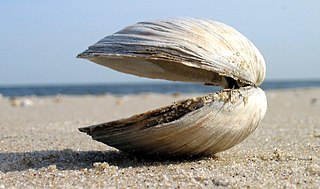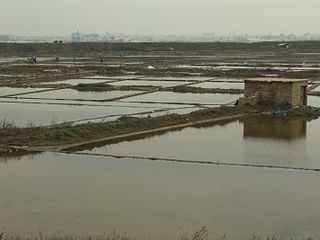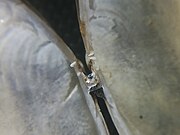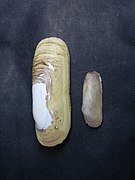
Clam is a common name for several kinds of bivalve molluscs. The word is often applied only to those that are edible and live as infauna, spending most of their lives halfway buried in the sand of the seafloor or riverbeds. Clams have two shells of equal size connected by two adductor muscles and have a powerful burrowing foot. They live in both freshwater and marine environments; in salt water they prefer to burrow down into the mud and the turbidity of the water required varies with species and location; the greatest diversity of these is in North America.

Hubei is an inland province of China, and is part of the Central China region. The name of the province means "north of the lake", referring to its position north of Dongting Lake. The provincial capital, Wuhan, serves as a major transportation hub and the political, cultural, and economic hub of central China.

Shandong is a coastal province in East China. Shandong has played a major role in Chinese history since the beginning of Chinese civilization along the lower reaches of the Yellow River. It has served as a pivotal cultural and religious center for Taoism, Chinese Buddhism and Confucianism. Shandong's Mount Tai is the most revered mountain of Taoism and a site with one of the longest histories of continuous religious worship in the world. The Buddhist temples in the mountains south of the provincial capital of Jinan were once among the foremost Buddhist sites in China. The city of Qufu was the birthplace of Confucius, and later became the center of Confucianism.

Mussel is the common name used for members of several families of bivalve molluscs, from saltwater and freshwater habitats. These groups have in common a shell whose outline is elongated and asymmetrical compared with other edible clams, which are often more or less rounded or oval.

Bivalvia, in previous centuries referred to as the Lamellibranchiata and Pelecypoda, is a class of marine and freshwater molluscs that have laterally compressed bodies enclosed by a shell consisting of two hinged parts. As a group, bivalves have no head and they lack some usual molluscan organs, like the radula and the odontophore. The class includes the clams, oysters, cockles, mussels, scallops, and numerous other families that live in saltwater, as well as a number of families that live in freshwater. The majority are filter feeders. The gills have evolved into ctenidia, specialised organs for feeding and breathing. Most bivalves bury themselves in sediment, where they are relatively safe from predation. Others lie on the sea floor or attach themselves to rocks or other hard surfaces. Some bivalves, such as the scallops and file shells, can swim. Shipworms bore into wood, clay, or stone and live inside these substances.

Dongyang is a county-level city under the jurisdiction of Jinhua in Central Zhejiang Province, China. It covers an area of 1,744.05 km2 (673.38 sq mi) and administers eleven towns, one township, and six subdistricts. It is part of the Yangtze River Delta Economic Region.

Tengzhou is a county-level city of Zaozhuang, Shandong province of the People's Republic of China, and is the site of the feudal vassal State of Teng during the Spring and Autumn period.

The eastern box turtle is a subspecies within a group of hinge-shelled turtles normally called box turtles. T. c. carolina is native to the Eastern United States.

China's vast and diverse landscape is home to a profound variety and abundance of wildlife. As of one of 17 megadiverse countries in the world, China has, according to one measure, 7,516 species of vertebrates including 4,936 fish, 1,269 bird, 562 mammal, 403 reptile and 346 amphibian species. In terms of the number of species, China ranks third in the world in mammals, eighth in birds, seventh in reptiles and seventh in amphibians.
Freshwater bivalves are one kind of freshwater mollusc, along with freshwater snails. They are bivalves that live in fresh water as opposed to salt water, which is the main habitat type for bivalves.

A bivalve shell is part of the body, the exoskeleton or shell, of a bivalve mollusk. In life, the shell of this class of mollusks is composed of two hinged parts or valves. Bivalves are very common in essentially all aquatic locales, including saltwater, brackish water, and freshwater. The shells of bivalves commonly wash up on beaches and along the edges of lakes, rivers, and streams. Bivalves by definition possess two shells or valves, a "right valve" and a "left valve", that are joined by a ligament. The two valves usually articulate with one another using structures known as "teeth" which are situated along the hinge line. In many bivalve shells, the two valves are symmetrical along the hinge line—when truly symmetrical, such an animal is said to be equivalved; if the valves vary from each other in size or shape, inequivalved. If symmetrical front-to-back, the valves are said to be equilateral, and are otherwise considered inequilateral.

Li Sizhong was an ichthyologist with the Institute of Zoology (中国科学院动物研究所) at the Chinese Academy of Sciences. Throughout his research career, he made numerous discoveries of new fish species, and published many books and research papers describing the fauna and geographical distribution of fishes in China and beyond. He translated and helped publication of the Chinese editions of Fishes of the World and Fish Migration. Li was the major author of two published volumes in the Fauna Sinica monograph series, systematically reviewing and describing orders of bony fishes that include flat fish, cod, silverside, pearlfish, killifish, flying fish, etc. in or near China. He had authored at least 60 academic papers, written over 40 popular science articles about fish on Chinese newspapers and magazines, and been responsible for compiling and editing fish-related entries in several standard reference books. His works on freshwater ichthyofauna of China as well as other aspects of ichthyology are considered to be among some of the most notable in the Chinese ichthyology literature.

The Shijing River is a small river in the Fujian Province of China. The tidal estuary it forms when entering the Weitou Bay of the Taiwan Strait is known as the Anhai Bay. Most of the Shijing River's basin is within the Prefecture-level city of Quanzhou.

Cipangopaludina cathayensis is a species of large, freshwater snail with an operculum and a gill, an aquatic gastropod mollusk in the family Viviparidae, the river snails.
China is a genus of grasshoppers in the family Chorotypidae. As of 2018, it is monospecific, consisting of its sole species China mantispoides. It is found in China, Thailand, and Myanmar. Malcolm Burr first circumscribed the genus in 1899; the species C. mantispoides was described in 1870 by Francis Walker. It is a pest of hickory trees.
Qilu culture, also known as Haidai culture, is a regional culture formed and developed centered in Shandong Province, China. The Qilu Cultural District is centered on the Taiyi Mountains, and its scope roughly includes the area east of the Beijing-Hangzhou Grand Canal in today's Shandong Province, northern Jiangsu Province, and the Liaodong Peninsula. It is consistent with the Jiaoliao Mandarin District and the Hebei and Lu Mandarin Districts in Shandong Province. To the west, it is bounded by the Grand Canal and the Central Plains Culture, and to the south, it is adjacent to the Jianghuai Culture in the Jianghuai Mandarin District. Qilu culture can be subdivided into "Western Lu culture" and "Jiaodong culture".

The FuxueConfucian Temple of Jinan is located in the Lixia District of the Jinan Prefecture, Shandong Province, China, south of Daming Lake and near old city streets such as Furong Street. It was first built during the Xining period of the Northern Song Dynasty (1068–1077) and rebuilt in the second year of the Ming Hongwu era (1369). By the time of the Republic of China, it had been expanded and rebuilt more than thirty times. The architectural complex faces north and sits south, with a strict layout and grand scale. Major buildings include the Dacheng Gate, Lingxing Gate, Pan Reservoir, Dacheng Hall, Minglun Hall, and Zunjing Pavilion.
Novaculina myanmarensis is a species of bivalve within the family Pharidae. The species was first described from Myanmar, in the Irrawaddy River near the Thin Baw Kone village, Pakokku District. More findings have exdended its range to the Salween River basin as well. Habitats include downstream and middle section of large freshwater rivers, with the species inhabiting gravel and clay substrates by making deep vertical holes for burrows. Measurments of the species are shell lengths of 20.5 to 46.5 mm, shell heights of 7.9 to 17.5 mm, and shell widths of 4.5 to 13.3 mm. It can be distinguished from closely related species from its more rectangular shell shape and truncated posterior end. In the downstream section of the Salween River the species is utilized as food by local villagers, in contrast to the Irrawaddy River where it isn't unutilized.


















